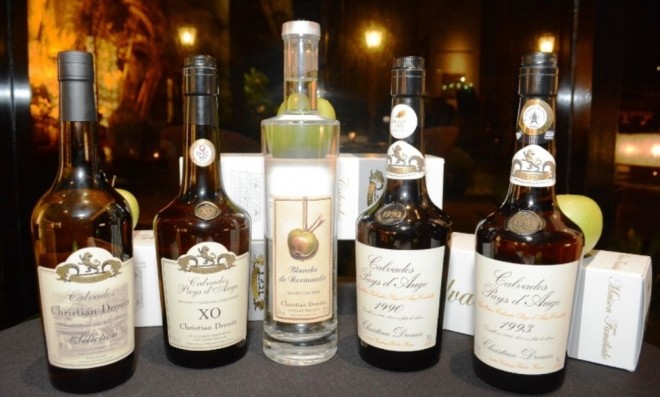
Speaking in English without a French accent, Christian Drouin introduced Normandy’s famous drink, Calvados. It’s essentially apple brandy, but with different kinds (five sampled that night) produced at the Christian Drouin estate.
Because the quality of the drink depends on where the apple trees are planted in the vast estate, each bottle will reflect that as well as the intended outcome by the spirit maker.
The significance of the place where Calvados is produced may be found in Carole Clements’ “A Flavor of Normandy” (Chartwell Books, 1996), which says that the region is one of the richest in France, famous not only for its apple spirits but also for cream, butter, cheeses, fish and shellfish, and charcuterie (preserved meats).
The Christian Drouin estate is located at Pays d’ Auge, one of Normandy’s five counties and known for cheeses—Camembert, Pont-l’ Évêque, Livarot—and, of course, the by-products of apple spirits (sometimes mixed with other fruits)—cider, Pommeau (Calvados and fresh apple cider blend), and Calvados.
Another county, Calvados, was named after a Spanish Armada ship, El Calvador, which Clemens mentioned in her book as having “struck a reef off the Normandy coast.”
Cocktails
Far from being an aperitif or a digestif (pre- or post-meal libation), Calvados the apple brandy was served as cocktails by the mixologist at Sofitel Philippine Plaza Manila. And then five kinds of Calvados were paired with that evening’s dinner courses.
A chicken liver pâté, wrapped with pancetta and flavored with Calvados, was accompanied by a colorless Blanche de Normandie. Drouin explained that the spirit was made from apples and pears. It reminded us of vodka, less smooth than what we were to taste later and very often used in the making of cocktails, as the Drouin website indicated.
A vintage Christian Drouin 1990 was paired with veal and two ingredients that Normandy is famous for—crème fraîche and Calvados. It had the familiar, deep amber-colored liquid, and was paired beautifully with the meat and vegetable dish.
An apple sherbet with Calvados was served to cleanse the palate; it also offered a taste of the 1993 Vintage Dated Calvados, a gold medal winner in the UK and France in a competition of spirits. It is 19 years old, including a year spent in a former Sauterne cask, giving it a honey, deep-fruit fragrance and flavor.
The cheese course featured the region’s Livarot from cow’s milk, a bit orange, usually because of the annatto used in the process. The multiawarded XO Calvados Pays d’ Auge was paired with it, double-distilled and golden in color. Its smooth feel in the mouth speaks of its long aging in casks.
We expected a sort of apple dessert, and indeed it came—a folded crepe with an apple pie filling on top and vanilla ice cream.
The end of the dinner was something lighter (than the Calvados before)—Christian Drouin Coeur de Lion, which a wine writer described as her “apple a day.”
Wine days
“An Evening in Normandy” is one of the events in connection with Wine Days 2015 ongoing at the Sofitel until the end of October. While wines are the focus, the food cannot be overlooked. The capable operations chef Bettina Arguelles and staff handled the French menus.
On another evening, it was a trip to Bordeaux via La Veranda, which featured the wines of Baron Philippe de Rothschild that Titania Wines of Tita Trillo distributes.
“Welcome back,” Tita said. It wasn’t to the wine-tasting that she greeted us, but to the Rothschild’s Bordeaux winery where she had brought us years ago to meet Philippine Rothschild, the vibrant former stage actress, daughter of Baron Philippe, who engaged us with stories about the chateau décor and the artists who painted labels for the winery.
We visited the museum where priceless artifacts were on display, as well as the huge dark cave where we looked for our year of birth but couldn’t taste our vintage.
Fruity notes
Winemaker Anthony Gourmel was at La Veranda to inform guests of each bottle’s merits. The light, refreshing Mouton Cade Blanc with its fruity notes and aroma of flowers enhanced the delightful salmon tartare.
The mostly merlot make-up of the Reserve Mouton Cadet Saint-Emilion made it a medium light red, still fruity and great with the seared duck breast (magret de canard) topped with foie gras.
The blackened Denver steak was served with Romesco, a Catalan sauce made with red pepper and almonds, usually eaten with seafood.
The drink that came with it was the star of the evening, a 2011 Château d’ Armailhac—a varietal mix of cabernet sauvignon, softened with merlot and flavored as well with cabernet franc and petit verdot.
Long and silky is how it’s described, and it was. We lingered a bit with the grand cru classé, to extend the pleasure of savoring a good wine.
Very French was the dessert of warm pear clafoutis served with an old friend, a Reserve Mouton Cadet Sauternes. Sweet, yes, but not cloying, and with wonderful fruit aromas.
E-mail pinoyfood04@yahoo.com.